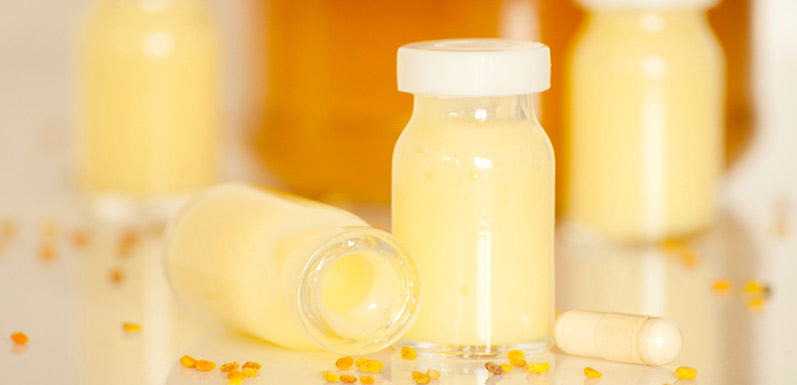Composition of royal jelly : Water, Proteins (N x 6.25), Sugars, Lipids, Minerals
17% of dry weight The sugars consist mostly of fructose and glucose in relatively constant proportions similar to those in honey.
Fructose is prevalent.
In many cases fructose and glucose together account for 90% of the total sugars.
The sucrose content varies considerably from one sample to another.
Other sugars present in much lower quantities are maltose, trehalose, melibiose, ribose and erlose.
The lipid content is a unique and from many points of view, a very interesting feature of royal jelly.
The lipid fraction consists to 80-90% (by dry weight) of free fatty acids with unusual and uncommon structures.
They are mostly short chain (8 to 10 carbon atoms) hydroxy fatty acids or dicarboxylic acids, in contrast to the fatty acids with 14 to 20 carbon atoms which are commonly found in animal and plant material.
These fatty acids are responsible for most of the recorded biological properties of royal jelly.
The principal acid is 10-hydroxy-2-decanoic acid, followed by its saturated equivalent, lO-hydroxydecanoic acid.
In addition to the free fatty acids, the lipid fraction contains some neutral lipids, sterols (including cholesterol) and an unsaponifiable fraction of hydrocarbons similar to beeswax extracts (Lercker et al., 1981, 1982, 1984 and 1992).
The total ash content of royal jelly is about 1 % of fresh weight or 2 to 3 % of dry weight.
The major mineral salts are, in descending order: K, Ca, Na, Zn, Fe, Cu and Mn, with a strong prevalence of potassium (Benfenati et al., 1986).
The vitamin content has been the object of numerous studies, from the moment when the first research (Aeppler, 1922) showed that royal jelly is extremely rich in vitamins.
Table 6.2 indicates the results obtained by Vecchi et al., (1988) with regard to water-soluble vitamins.
Other authors report averages close to the minimum values of Table 6.2 (Schmidt and Buchmann, 1992).
Only traces of vitamin C can be found.
As far as the fat-soluble vitamins are concerned, it was initially thought that, given the enormous fertility of the queen bee, royal jelly would contain vitamin E.
But tests have shown that it does not.
Vitamins A, D and K are also absent (Melampy and Jones, 1939).
During the first studies, much emphasis was placed on the search for sex hormones in royal jelly.
The first positive tests were later proven wrong.
Melampy and Stanley (1940) showed no gonadotropic effects on female rats and Johansson and Johansson (1958) clearly demonstrated the absence of any human sex hormones.
Recently though, with much more sensitive radio-immunological methods, testosterone has been identified in extremely small quantities: 0.012 ~g/g fresh weight (Vittek and Slomiany, 1984).
In comparison, a human male produces daily 250,000 to 1 million times the amount present in one gram of fresh royal jelly (Schmidt and Buchmann, 1992).
No biological effect has been demonstrated for such small amounts.



